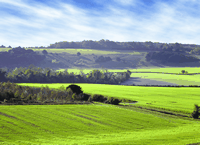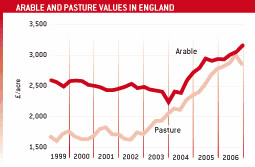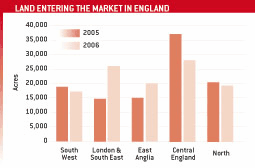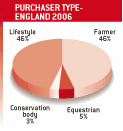Strong demand keeps land prices high into the new year

Like many agents at the start of last year, we predicted that the volume of farmland being offered for sale over the next 12 months would be greater than in previous years.
And although we expected the number of buyers would remain strong, there was a chance that, with supply increasing, land values would come under pressure.
It was generally held that after the foot-and-mouth crisis in 2001 and the announcement of the reform of CAP in 2003, followed by the transition to the Single Payment System (albeit with considerable problems), a greater number of farmers and landowners – many of whom had held off until SPS was up and running – would consider a sale.
Now, with the benefit of hindsight, we can see this prediction did not, in the main, come true. During 2006, 111,185 acres of land were launched on to the open market in England – only 4% more than the amount entering in 2005.
This minimal increase was primarily due to an exceptional number of large sales in Hampshire. As the barchart opposite shows, the south west, central England and the north had fewer acres marketed than the previous year, with only a marginal increase in East Anglia.

One-off
The acreage in the south east, almost double the previous year, comprised a handful of substantial farms and estates of more than 1000 acres, and this must be regarded as a one-off. It was led by the launch of The Forest Farm Estate, six miles outside Winchester, in April.
This 1200-acre property combined a private location with beautiful countryside, good commercial arable farming, a first-class pheasant and partridge shoot and planning consent for a principal house.
It was the first of the offerings in Hampshire and attracted over 40 potential buyers and eight bids culminating in a sale well above its £6m guide price. At least two of the unsuccessful under-bidders went on to acquire Hampshire estates that followed Forest Farm to the market, with another buying an attractive small estate in Gloucestershire.
The 40 viewers at Forest Farm all had funds to buy farms and estates worth more than £5m, with the vast majority still looking at the end of the year. The demand has led to a rise in land values, with arable land in England increasing by 7.5% on average over the 12 months to £3161/acre and grassland at £2870/acre (see line graph below).


Peak
Although the graph appears to show a fall in grassland values in the last quarter of the year, a more accurate interpretation would be that the September peak, at £3000/acre, was the result of a small volume attracting a premium price with grassland returning to the levels of the spring and early summer.
Despite the marginal increase in land launched in 2006, at the end of the year 54,000 acres remained available, almost exactly the same as at the end of 2005.
The ever-increasing demand for land has, in previous years, been led by the strength of the economy. Buyers from a non-farming background, categorised as “lifestyle” purchasers, dominated the market, particularly in the south east.
In 2006 their numbers continued to increase, but they are now facing renewed competition from farmers buoyed by the long-awaited increase in commodity prices.
Not surprisingly, farmers have been most successful in acquiring land in East Anglia and central England. Interest focused on the higher quality soils where a greater proportion of the value of the holding is attributable to the land and buildings rather than the residential property.

lifestyle buyers
The pie chart above is an analysis of the farms sold by us this year and shows 46% of purchases by farmers, equalling the acreage sold to lifestyle buyers, with 5% to pure equestrian-oriented buyers and 3% to conservation bodies.
The farmer category includes a considerable number of European buyers, particularly from Ireland and Denmark, where values are on average three times greater than those in England. Most Irish and Danish buyers are primarily looking to invest, rather than relocate.
Even two 0.25% interest rate rises during the course of the year failed to dent buyers’ enthusiasm. I think this is because people are comfortable borrowing at 5%, which is around the 20-year average.
I think the market, especially at the top end, will stomach another 0.5% rise without batting an eyelid. If rates went beyond 6% that would probably start to have an effect, but I don’t think any analysts are predicting that will happen.
In Scotland, the market mirrors that in England and has remained incredibly strong throughout 2006. About 99,000 acres were sold in Scotland during 2006, a staggering 300% more than that sold in 2005.
But almost a third of this was formed by the sale of the 30,000-acre Cameron Farms, owned by former NFU Scotland president John Cameron.
Values continue to rise, with arable land in central Scotland and the Borders averaging over £3000/acre.
FORECAST FOR THE 2007 MARKET-CONTINUED CONFIDENCE |
Overall, we have seen a rise in the amount of land entering the market in 2006, but in reality in the south west, central England and the north, less was offered than in 2005 while East Anglia showed a marginal increase. The only large rise was in the south-east and we regard this as a “one-off” and believe the overlying trend of a falling acreage offered for sale will continue into 2007. Renewed confidence in farming might sway the decision of those who were contemplating sales in the coming year. And, at the same time, the number of buyers for farms and estates continues to grow. “Lifestyle” purchasers from outside the industry are increasing, with the number of millionaires in England rising on a daily basis. From all walks of business life, not just those with the well-publicised city bonuses, there are buyers attracted by rural property. In 2006 the lifestyle purchaser found renewed competition from farmers in England buoyed by the rise in commodity prices. This renewed confidence is likely to continue in 2007. The only cloud on the horizon could be nerves about what the economy might do towards the end of the year. Everybody is borrowing furiously and one has to worry about such heavy levels of debt. We predict that arable and grassland values will increase on average by up to 10% in 2007 driven by a fall in supply and increasing demand. Average increases are likely to fluctuate regionally and the likelihood is for premium prices for well-located farms and estates with an attractive principal house. |
*Read more about the growing optimism surrounding farming businesses
Related Links:
